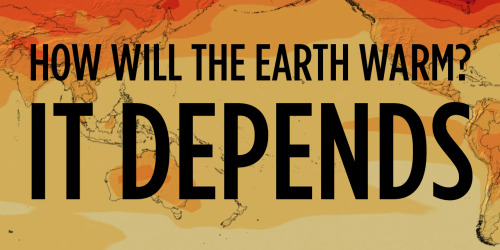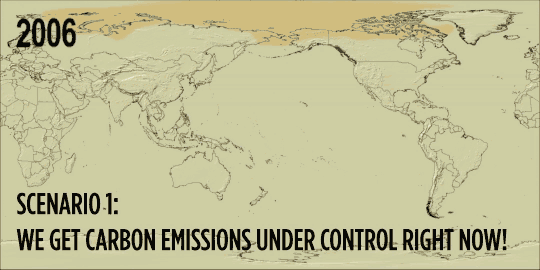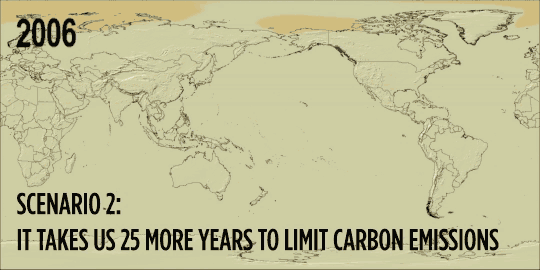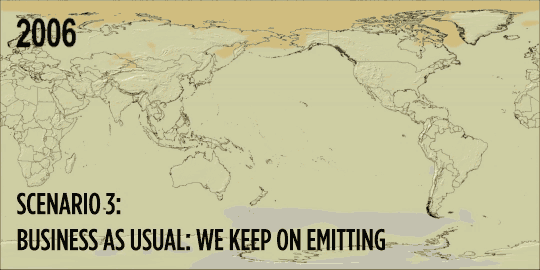The Sex Of A Sea Turtle Hatching Is Determined By Temperature. Nests Incubated At Cooler Temperatures

The sex of a sea turtle hatching is determined by temperature. Nests incubated at cooler temperatures produce more males, while nests incubated at warmer temperatures produce more females.
This could be a problem with climate change. As global temperatures rise, nests will be incubated at higher temperatures, producing fewer males. As this study found, climate change could lead to turtle nests with few to no males, skewing sex ratios and endangering the persistence of sea turtle populations. As the authors note:
“[O]nce incubation temperatures are 35°C, there are almost no more males produced (1 per 50 000 eggs laid)... As turtles return to the rough neighbourhood of their natal breeding grounds, it seems likely that for populations already producing more than 80% females, there will be a real extinction risk if they continue to nest at the same time of year and conditions warm by a few degrees.”
But the bigger issue may be the increasing number of unviable eggs with rising temperatures. As the authors claim:
“[T]he primary concern in scenarios of climate change and rising incubation temperatures [is]... the high hatchling mortality in excessively warm nests...While climate warming still poses a threat to sea turtles, it is not the skewed sex ratios per se that will threaten population survival but rather higher mortality within clutches.”
More Posts from Envirographs and Others

From mic.com:
This map traces the ideal deployment of solar energy plants in the Sahara Desert to generate electrical power for the world's population. It might not look like a lot, but there are some major caveats here. For one, this map seems to assume 100% efficiency. In reality, current solar panel technology is only able to capture around 20% of solar energy, even in the desert. So the 254-by-254 kilometer area in the Sahara Desert that could theoretically absorb enough rays to power the entire world would have to be five times larger. Second, large amounts of electric power are lost over large transmission distances, meaning that a single power plant could never really power the entire planet.
Still, this map is a good illustration of how little space would be needed to power the entire planet. According to May, some 3.49 million square kilometers are available for solar thermal power facilities in Morocco, Algeria, Tunisia, Libya and Egypt alone. Worldwide, the potential high-energy solar sites far outstrip any plausible need.

The conservation status of turtles and tortoises, nearly 60% of which are threatened. Many critically endangered turtles are in Asia, such as the Yunnan Box Turtle, Yangtze Giant Softshell Turtle and Philippine Pond Turtle. The leatherback and hawksbill sea turtles are also critically endangered.





As governments discuss climate change in Paris, they’ll be referring to the dire predictions of climate scientists. Here are three visualizations of possible futures based on detailed climate models and summed up by the United Nations’ Intergovernmental Panel on Climate Change (IPCC) in their 2013 report. The deeper the red - the hotter things are getting.
The message is clear: we better act fast.
How did they come up with these models? Read or listen to Nell Greenfieldboyce’s story.
Image Credit: NASA’s Scientific Visualization Studio and NASA Center for Climate Simulation

Average annual net loss and gain of wetlands in the lower 48 states of the U.S. Wetlands protection regulations (such as those under the Clean Water Act 404), incentive programs (such as the Wetlands Reserve Program) and disincentive programs (such as the Swampbuster provision of the Food Security Act of 1985) have substantially reduced wetlands losses.



While the average household today consists of fewer people than 60 years ago (2.55 people vs. 3.37 people), the average house size has increased by over 150%. Bigger houses (despite smaller families) means more energy used to heat and cool, more land cleared to build, and more materials required for construction.

October 2017 was the warmest October on record for all 6 New England states.

Every year a dead zone forms in the Gulf of Mexico. This year’s dead zone is the largest on record.
From the New Orleans Times-Picayune:
“Nitrogen and phosphorus pollution enters the Mississippi [River] throughout its watershed, which includes runoff from the Midwest cropland and factory livestock and chicken farms, and pollutants from sewer systems and septic tanks in other locations...The lighter freshwater containing the nutrients creates a layered effect when it reaches the Gulf and the nutrients trigger blooms of phytoplankton - microscopic marine algae - in the spring and summer. The fresher, warmer water in the upper layer is separated from the saltier, colder water in the lower layer, resulting in a barrier to the normal diffusion of oxygen from the surface to the bottom... When the algae dies and sinks to the bottom, it decomposes, using up oxygen in the deeper heavy saltwater and creating dead zone conditions. Those conditions don't change until wind or weather, especially tropical storms or hurricanes, mix the freshwater at the surface into the saltier water.”
A monitoring cruise measured a dead zone of 8,776 square miles, “4 1/2 times the size of the of the goal of about 1,950 square miles set by the federal-state Mississippi River Nutrient/Hypoxia Task Force.” The result are marine life, such as crabs and crustaceans, that die due to oxygen deprivation.

The annual energy potential of renewable versus nonrenewable energy sources

From Nature:
“[U]nlike the other [large American] predators, coyotes have thrived in the past 150 years. Once restricted to the western plains, they now occupy most of the continent and have invaded farms and cities, where they have expanded their diet to include squirrels, household pets and discarded fast food.
Researchers have long known the coyote as a master of adaptation, but studies over the past few years are now revealing how [they] succeed where many other creatures have suffered. Coyotes have flourished in part by exploiting the changes that people have made to the environment.
Also, fun fact:
The [coyotes] that arrived in the northeastern United States and Canada in the 1940s and 50s were significantly larger on average than those on the Great Plains... [Researchers] found that these northeastern coyotes carried genes from Great Lakes wolves, showing that the two species had interbred as the coyotes passed through that region. “Coyotes mated with wolves in the 1800s, when wolf populations were at low density because of human persecution,” says Kays. In those circumstances, wolves had a hard time finding wolf mates, so they settled for coyotes.
Compared with the ancestral coyotes from the plains, the northeastern coyote–wolf hybrids have larger skulls, with more substantial anchoring points for their jaw muscles. Thanks in part to those changes, these beefy coyotes can take down larger prey.
A visual exploration of environmental problems, movements and solutions.
151 posts